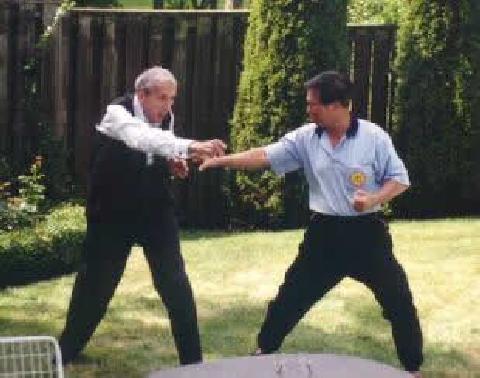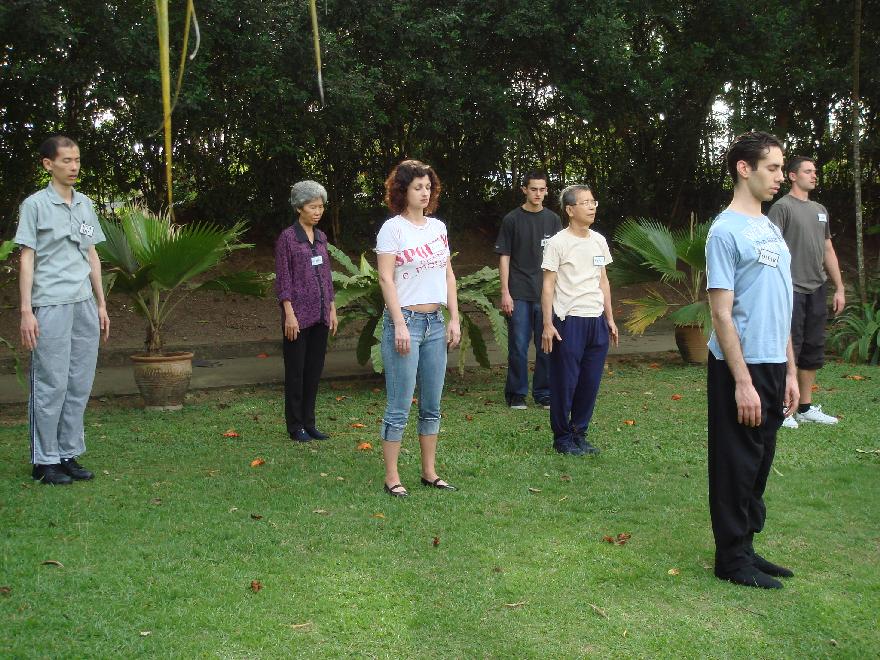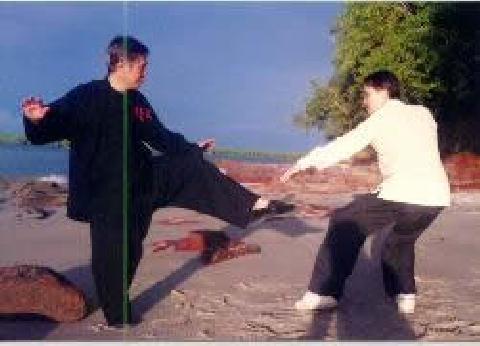March 2000 (Part 2)
SELECTION OF QUESTIONS AND ANSWERS

Robert Trout, age 90, is Sifu Wong's oldest student. Here Robert is engaged in a Shaolin Kungfu training session with Sifu Wong
Question 1
I would like to know how to attain the state of no-mind? Is it through detachment, is it through functioning from a state of mind where one does not expect anything in return, meaning doing things for others without any expectation? Or is it living for others without any expectation from others?
— Anupama, India
Answer
No mind, or “wu-xin” in Chinese, is actually all mind. It is a Zen term referring to a “state” where an adept has discarded his personal mind and attained the universal mind. This state of no mind may be attained at different levels.
At a lower level, an adept has a glimpse of cosmic reality. He may, for example, directly experiences that he does not have a physical body. In other words, he realizes through his own personal experience that the phenomenal world is unreal.
Should anyone think this is impossible or this merely exists in spritual texts, let him be assured that some of my students have had such an experience. In Zen, this is called an awakening, or “satori”.
At the highest level, an adept directly experiences that he is actually the eternal and the infinite! In other words, he attains nirvana, called by various peoples as return to God's Kingdom, meging with the Great Void or realizing the Tao.
Is attaining no-mind through detachment, through functioning from a state of mind where one does not expect anything in return, meaning doing things for others without any expectation, or living for others without any expectation from others? The answer is yes and no. This is a good example illustrating that in the internal arts without deep understanding or better still personal experience, merely reading an instruction for a particular training may often give a misleading answer.
A master may rightly say that to attain no-mind, one must be detached. But your and most people's conceptualization of the master's statement is likely to be very different from what he actually means. Detachment, not expecting anything in return, etc are just pre-requisites. They are needed for no-mind cultivation, but by merely being detached or not expecting anything, one cannot attain no-mind.
As an analogy, studying is a pre-requisite for passing an examination, but merely studying does not necessarily make you pass the examination. Sitting in a lotus position or performing kungfu movements are pre-requisites for meditation and kungfu respectively, but if you just sit in a lotus position or perform kungu movements you are not performing meditation or kungfu.
The way to no-mind or all mind as tuaght by the Buddha consists of three stages, namely
- Avoid all evils.
- Do good.
- Cultivate the mind.
One can attain the state of no-mind (but not its highest level) by merely cultivating the mind without avoiding all evils and doing good. But the result is certainly harmful. This is not moralizing; it is a cosmic truth. If one develops a powerful mind without first purifying it, the power of an evil mind will first harm itself. This explains why many Western psychics, who did not have a spiritual base for their psychic development, had such miserable lives.
Mind training is very powerful and delicate. To cultivate for no-mind, Zen monks devote themselves full time and for many years in a monastery. It is ridiculously egoistic for any person to imagine he (or she) can achieve similar results by practising from a book for a few weeks — and then teach others. It is also unwise to dabble in mind training without a master's guidance.
Question 2
I didn't know this until you cleared some obstacles and shed some light on my situation. When I used to do Zhan Zhuang, I always generated incredible energy. My lower back would hurt and would remain that way until I stopped for at least a couple of weeks. Every time I returned to practice, it would start up again.
Let me describe the pain. It wasn't like sore muscles or torn or bruised tissue. It couldn't be touched, and it came and went throughout the day. It was severe and felt like the type of internal pain you feel when you had the flu really bad. I just ached terribly inside. I've been in sports and played with broken bones so I can take pain, but this pain was like nothing I felt before. It couldn't be localized or touched by contact. So I decided to get a spinal x-ray and ultrasound and nothing showed up. This pain lasted for 2 years and only stopped when I stopped Zhan Zhuang and went to an acupuncturist.
I only told her I was having back pains. She looked at my tongue and felt a pulse and said that my kidney line was weak and I had too much yang energy/too much heat. The treatment worked immediately. I recently started Zhan Zhuang again but after only two days, the same unmistakable pain came back, and let me tell you that there is no pain that feels this way.
— Francis, USA
Answer
Yours is a problem of too much energy locked up in your body, probably in your muscles. Had the energy been locked up in a major meridian or a vital organ, you could be in serious trouble.
Conventional medicine could not detect it because conventional medicine does not have the appropriate philosophy to understand this energy problem, nor the vocabulary to describe its situations. Physical exercises would not bring about similar problems because physical exercises work at the physcial level only.
But don't worry. Your problem can be overcome quite easily. The best action is to consult a genuine chi kung master. A good acupunturist can help, but the diagnosis must be accurate. If the acupuncturist missed the exact meridian, there may be little effect.
Chi kung is faster, and exact diagnosis is not even necessary! This is because once you or the chi kung master sets your chi to flow, it will naturally flow to the problem areas — this is the wonderful characteristic of chi.
If you cannot find a genuine chi kung master or a good acupunturist, the following remedial exercise is useful. Stand upright and relax. Perform “Lifting the Sky” about 20 times. Immediately after this, perform “Carrying the Moon” about 30 times. You must perform the movements in a relaxed manner. Speed up towards the end of the sequence. After about the 30th time of “Carrying the Moon”, just let go and let your chi flow take over. Enjoy the spontaneous chi movement for about 10 minutes. Slow down, stand still for a few minutes then complete the routine. Perform the routine three times a day for at least three months.
Do not practise any form of Zhan Zhuang for the time being. You may resume your Zhan Zhuang after the pain has completely disappeared.
Question 3
I am now 15 years old. Am I too old to start kungfu?.
— Kim, Malaysia
Answer
No, you are certainly not too old to start kungfu. My oldest kungfu student is Robert Trout of New York. He came all the way alone to Malaysia and started learning kungfu from me when he was 87. This itself was an achievement — many people after 70 dare not even go out of their house. He is now 90 and still practises his kungfu everyday.
When I first met him he was 85. He had a serious heart problem then and could not even walk properly. He invited me to New York to teach him chi kung, which not only cured him of his heart problem but also strengthened him. I am very proud of him. He is an inspiration to all of us.

Students at an Intensive Chi Kung Course enjoying "no-mind"
Question 4
I do a lot of streches every morning when I wake up.
Answer
Stretching is a good exercise especially for young people of your age. If after stretching you stand upright in a totally relaxed manner for about five minutes doing nothing and thinking of nothing, you will get much more benefit.
You and many other people may find it hard to believe, but this standing-doing-nothing-and-thinking-of-nothing exercise is so simple yet so profound. This is an exercise that many masters do every day. After some time, you may find your body swaying gently. Just enjoy the gentle sway — this is your chi (or vital energy) flowing inside you. After the exercise you will find yourself mentally fresh and energized.
Question 5
Sadly, in my area there is no school to teach Kungfu.
Answer
Perhaps you have not searched enough; there are actually many schools teaching kungfu in your area. But much of the kungfu taught, as elsewhere in the world, is mainly external kungfu forms. There are also many schools teaching modern wushu.
It is useful to know that although in Chinese the word “wushu” means “kungfu”, in practical terms there is much difference between modern wushu and traditional kungfu being taught today.
Question 6
I also went to bookshops to search for any martial arts book about Kungfu, but sadly I found none. I recently started surfing the net and I stumbled upon your homepage. I was very delighted but confused. Maybe it's because I don't know the basics.
Answer
My kungfu book, “The Art of Shaolin Kungfu”, will be very helpful. It is sold in your area but is often out of stock. You can order it from Amazon.com through my homepage.
As there is so much information in my website, it is understandable that you may be confused, especially if you do not know the basics. A good way is to start with the following webpages in the order given:
- The aims and objectives of practicing kungfu
- Various styles of kungfu
- Getting the best benefits from your training
The information from my webpages (or from my books) merely shows the way. You still have to learn personally from a master, or at least from a competent instructor. You may find that what most masters and instructors teach may not be the same as what I have described. This is understandable as different teachers may approach kungfu differently.
Question 7
Anyway, the main reason I wrote this e-mail to Sifu was to ask whether I'm too old too start. Besides that, does size really matter if you want to take up martial arts?
Answer
One can practise kungfu at any age (of course leaving aside babies). Different types of kungfu, however, are more suitable for certain age groups.
For example, children between the age of 5 and 12 should practise kungfu of the more external type with a lot of jumping and stretching. As their bodies are still growing, they should not engage in force training that demands body conditioning, such as punching sandbags or striking poles.
Young people between the age of 13 and 21 can engage in “harder” kungfu but they must take care not to deform their bodies, such as deverloping callused knucles or crooked shins. Their young bodies and minds are also not ready for serious internal force training.
Those between 22 and 49 are ripe for any training, but career and family commitments may sometimes need considerations. Those between 50 and 70 may not be agile but can still be fast, and are better at training that demands patience and endurance. Elderly people beyond 70 are generally too slow for vigorous actions, but can be powerful with flowing chi movements.
In genuine kungfu, size matters — to the advantage of the person. A good master will consider a student's size in selecting the right type of kungfu for him (or her). If he is small sized, he will be suitable for fast movements and agile footwork. When his opponent attacks, he will not block but move to the sides or back of the opponent and counter strike. If he is big sized, he will make full use of his weight and strong arms. When an opponent attacks, he blocks head-on, moves straight into the opponent and strikes — without having to bother with such intricacies as dodging the oppoent and avoiding his force.
In most other martial arts, where the same techniques are used irrespective of the size of the exponent, size matters — to the disadvantage of the person. In judo, for example, despite what many judokas claim theoretically, if you are small sized, you will find it much harder to throw a big sized person. In taekwondo, if you are big sized you will find it more tiring to bounce about before moving in with a flying kick.

A snap kick to the groin can break a Golden Bell. Hence, although Goh Kok Hin is trained in Golden Bell, instead of taking the kick and counter-striking Sifu Wong at the same time, he moves back to avoid the kick and simultaneously striking the kicking leg
Question 8
I was very impressed by the countermoves you posted on your home page against Muay Thai techniques. They are simple, effective, and potentially devastating. What I found very interesting in particular on your page, was that a kung fu master would be unaffected by physical strikes because of “Iron Shirt” and “Golden Bell” techniques.
— Sage, USA
Answer
This is speaking relatively, i.e. a master who has “Iron Shirt” or “Golden Bell” would be unhurt if an average person strikes him ordinarily on his body. If a very powerful person strikes him ordinariily on his body, or if an average person strikes him at a weak spot like his eye or groin, the master would be hurt.
Hence, in the past masters who had “Iron Shirt” or “Golden Bell” would not want others to know about his ability so that his opponents would not make special effort when attacking him.
Question 9
However, would such techniques work against strikes which do more than just bruise the torso, as most strikes do? For example, would they work against a knee to the base of the spine, designed to crush the nerve bundle center found there? Would they work against a strike or finger gouge to the eyes? Would they work against a crushing grab to the genitals?
Answer
Unless the master's “Iron Shirt” or “Golden Bell” is extremely powerful, such strikes will injure the master. But of course he will not allow such strikes to connect as he will neutralize them.
Question 10
And finally, would they work against joint-breaking techniques? For example, if someone were to grab a kung-fu master's head, and twist it to the side and upwards at the same time, would his neck not snap?
Answer
Normally his neck would snap. Hence he will have to depend on counter-techniques rather than on his “Iron Shirt” or “Golden Bell”.
However if the master's force is tremendous relative to the attacker's force, then the joint-breaking or other attack techniques would not work. And while the opponent is pre-ocupied with applying the attack, the master can strike him decisively.
As a comparison, a child would be unable to snap the neck of a powerful adult even though the child may use a joint-breaking technique correctly. Meanwhile the powerful adult can hurt the child.
